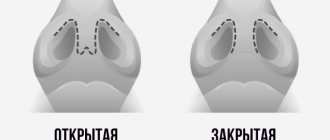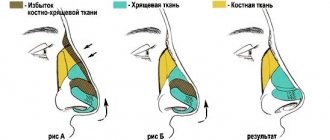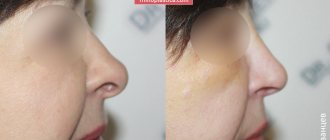Let's clarify. The wings of the nose are two paired cartilages, which, located at the base of the nose, actually form the nostrils.
In some cases, plastic surgery of the wings of the nose is a truly effective way of transforming an unattractive nose into a completely attractive one and correct in terms of proportionality in relation to other parts of the face. Moreover, without serious surgical intervention affecting bone tissue and requiring long-term rehabilitation. Of course, this option is not suitable for everyone, but only for people who:
- the wings of the nose are excessively long, thereby greatly lengthening the nose;
- the nostrils are characterized by excessive width (even when the back is narrow), which makes the nose as a whole wide and not very neat;
- the nostrils are narrow and disharmonious with the rest of the nose and the face as a whole;
- there is asymmetry, congenital or acquired deformation, recession of the nostrils;
- the nostrils are excessively thick due to an anatomical feature when the skin or cartilage tissue is thickened.
Correction of the wings of the nose can be an independent operation or one of the stages of complex rhinoplasty. If necessary, the surgeon recommends performing septoplasty during the operation if there are difficulties with nasal breathing due to curvature/displacement of the nasal septum.
How do you know if nose wing correction alone is enough in a particular case? Come for an appointment with our specialist. The doctor will conduct an examination and determine the optimal intervention tactics, after which the nose will take on the desired appearance and will no longer spoil the appearance.
The list of contraindications is limited to “standard” conditions and diseases for which it is advisable not to use general anesthesia (if local anesthesia is used, they are not taken into account). In addition, correction of the wings is not carried out in the presence of inflammation and unhealed soft tissue damage on the outside of the nose and in the nasal cavity.
Methods of performing rhinoplasty surgery
There are the following methods of carrying out the procedure:
- closed;
- open.
We would like to note right away that rhinoplasty can be done in our specialized clinic only through a closed method.
Rhinoplasty in Moscow in accordance with open access technology is used by less experienced plastic surgeons, and this type is also recommended for use in cases of fairly extensive damage. Thanks to the incisions made in the soft tissues, the doctor greatly facilitates the conditions for his work. However, during the operation, vascular damage occurs, which leads to impaired blood circulation inside the tip of the nose. With this method, postoperative rehabilitation is significantly complicated and slowed down.
The advantage of closed access is that after the operation, traces of surgical intervention are practically invisible. This is possible due to the fact that the incision is made by an experienced specialist directly inside the cavity. With the closed method, the desired result is achieved at a higher quality level. At the same time, the period of postoperative rehabilitation is significantly reduced, and internal damage is minimized. The advantages of closed access are immediately obvious, but it is worth carefully studying the contraindications. Still wondering: where to get rhinoplasty?
Rhinoplasty clinic in Moscow
High efficiency and complete safety of using the closed method are ensured thanks to the unique author’s development of Dr. Tigran Aleksanyan. The best plastic surgeon for rhinoplasty was one of the first practicing doctors to completely abandon open surgery. Today Tigran Aleksanyan successfully carries out a wide variety of operations of any degree of complexity using only a closed method. This allows you to reduce vascular damage and trauma during the operation, ensure an ideal final result, and significantly speed up the rehabilitation course and make it painless.
Bloodless rhinoplasty of the nasal tip provides an excellent opportunity to perform detachment and resection of soft tissues with minimal blood loss. At the same time, the impeccability of the result is achieved by eliminating complex injuries, which often cause the formation of certain thickenings, internal scars, facial expression disorders, and partial or complete numbness of tissues. Our plastic surgeons have proven in practice that the accuracy of predicting the final result when using the bloodless surgery method is several times higher. This is explained by the fact that the occurrence of postoperative complications and deformities has been reduced to almost zero. Therefore, we can fully say that Art Plastic is the best rhinoplasty in Moscow. Please note that there are contraindications for certain groups of people.
Plastic surgery of the tip of the nose
The rhinoplasty operation includes the following components:
- Anesthesia and, if necessary, an additional painkiller are administered.
- A surgical incision is made inside the nasal cavity. In this case, a point is specially selected where the accumulation of blood vessels is not so dense. This makes it possible to reduce the risk of injury to the lymph nodes and circulatory system, as well as the formation of hematomas and swelling in the postoperative period.
- Detachment of soft tissues is carried out using a special proprietary method. Thanks to a unique technology, the blood circulation of the components of the nose and the activity of the lymphatic system are preserved during the detachment process.
- Correction of existing curvatures, irregularities and other types of existing defects is performed.
- Cartilage or bone tissue is built up (if necessary). For this purpose, both your own nasal tissue and tissue taken from other parts of the body are used. We do not recommend and practically do not use grafts made from artificial materials. This makes it possible to minimize the risk of various complications.
- Sutures are placed on the incision made during the operation.
Depending on the desired result and the degree of complexity, the duration of the procedure can vary from 50 minutes to 2 hours or more.
Mistakes during rhinoplasty and their elimination
“What worries my patients worries me terribly” (c)
I understand that being able to dream of having no problems after rhinoplasty is a shameful luxury. Unfortunately, this is not always the case.
Let's try to understand (and perhaps admit) possible surgical errors during rhinoplasty and the conditions (complications) to which they lead. A number of events prompted me to try to open up this topic and come out of my calm surgical hiding place: firstly, a certain number of disappointed patients at the initial appointment, and, secondly, a critical attitude towards what I heard and saw at the last ISAPS session and at the subsequent one Russian-language rhinoplasty event, where both beginner rhinoplasty and undoubted heavyweights performed. What is the reason? Some crisis of inspiration, failing health or a soulless operating attitude??? Maybe financial well-being brings its relaxing wormhole into the disciplined surgical format? Who knows ….
The biggest mistake (no matter how top-class a surgeon may feel in the rhinoplasty field) is to assume that mistakes cannot be avoided (note – mistakes!), as well as, oddly enough, most complications. Here, I think, we need to stop and explain how important this is!
Someone called complications a sophisticated form of error in a strategic sense, i.e. Having allowed complications to develop, the surgeon thereby admits that he was unable to adequately assess the risks of their development and/or at the technical level was unable to bring to life (working with a scalpel in his hand) the pictures born of his imagination (“as I see it”) ") into a specific result. I am sure that the brain of every surgeon, as soon as he sees the patient, begins to sort through the hidden rhinoplasty possibilities inherent in the anatomical characteristics of his nose, building a certain technical combination in his head. And if everything is taken into account correctly, everyone (both the patient and the doctor) likes the result; it is simply etched in the memory, demonstrated on various forums and websites. However (without any irony), due to certain circumstances, this does not always happen. I would venture to offer you a “classification” of errors, digging the topic a little deeper.
So, first of all, we need to divide all the mistakes/complications according to the principle: 1) the surgeon “overdid it” (all technical elements or one of them were performed “assertively” and are best combined with the word “too” - too much skin was resected in the columella area, too large a section of the distal edge of the septal cartilage has been removed, the projection of the nasal dorsum has been reduced too much, etc.;
2) the surgeon was “underperformed” (“pale” and (or) poor surgical design, inconsistency of the applied techniques with the level of complexity and tasks during rhinoplasty).
If you enter (conditionally, of course) a certain equivalent of rhinoplasty activity (“E.R.A.”) during the operation (taking E.R.A. = 10 as a standard) and display it in points, then, in the first case, ERA. will be clearly more than 10, and, in the second, on the contrary, significantly less. It is also necessary to highlight technical errors (poorly executed lateral osteotomy, too superficial skin detachment, etc.) and strategic ones (for example, underestimation of the degree of skin contractility in the postoperative period, imperfection of the septal angle, or too much alar cartilage resected). Further, you can divide all the errors, guided by topographical considerations, highlighting errors when working with the septum, tip of the nose or dorsum. In this article, I will probably focus on the most common (in my opinion) and typical rhinoplasty mistakes.
1. Too superficial skin detachment during surgery. The skin of the nose varies in thickness: it is thinner at the root of the nose and on the back, gradually thickening towards the tip. It is important to remember that the skin in the area of the tip of the nose is tightly fused with the alar cartilage, but moves freely in the dorsal area (the skin is nourished through a network of superficial vessels), so skin detachment during surgery must be carried out closer to the cartilage and bones of the nose, and not to the surface skin. Superficial detachment of the skin threatens with trophic disorders, and, in its worst case, with necrosis of the skin area. Seeing a necrotic area of skin and at the same time a questioning look from the patient is the worst picture for the operating doctor to contemplate at the moment of removing the plaster cast, and can cause both feelings of fear and guilt (about the same as a vegetarian feels while in a crowded steakhouse).
Violation of skin trophism. After removing the plaster cast, there is necrosis of the skin in the area where the bridge of the nose transitions to the tip. The edges of the wound are connected with fixing sutures
2. Asymmetry when performing intranasal approaches. This is possible if the surgeon is not distinguished by self-control (but, on the contrary, haste) and has a fatal tendency to neglect arithmetic measurements before making incisions. This leads to asymmetry of the tip of the nose and nostrils (you can find more detailed information in my article about intraoperative markings during rhinoplasty).
3. Excessive removal of columellar skin and distal edge of septal cartilage. This can lead to the so-called. “blind nose” condition, when the columella is retracted and is almost level with the nostrils of the nose. Normally, it should be of sufficient length to ensure that the tip is above the line of the dorsum and be 2-3 mm below a straight line drawn through the edge of the wings of the nose. If this is not observed, the tip of the nose will droop.
Blind nose - no columellar part
4. Excessive excision of wing cartilages. It can lead to disruption of the supporting apparatus of the nose, softening of the nostrils, and is clinically expressed in the form of a “valvular” nose: sticking and unsticking of the nostrils during inhalation and exhalation, and, in some cases, the development of the so-called. "beak" (parrot's beak).
Excessive resection of alar cartilages and supporting apparatus of the nasal tip
5. Excessive reduction in the projection of the nasal bridge. When working on the dorsum of the nose, more than necessary amount of osteochondral tissue is removed and, as a result, a low concave dorsum of the nose is formed, the so-called. "boxer" nose. (Perhaps the presence of such a nose on a friend fills the man next to him with confidence, but to me this shape of the nose seems to be, how can I put it mildly... let's stick to the unrefined!).
Saddle or boxer nose
6. Flaw in the “septal angle”. It can negate all the efforts expended and lead to the formation of a thickening in the area of the transition of the bridge of the nose to the tip, which, of course, causes a feeling of annoyance in both the doctor and the patient and, after some time, their relationship becomes covered with unpleasant cracks and discussions corrective surgery.
.
Insufficiently resected cartilaginous part of the osteochondral hump + unfinished septal angle
7. Incorrectly performed lateral osteotomy. The osteotomy line should be clean and low enough, and symmetrical on the right and left. In case of incorrectly performed lateral osteotomy, a “stepped” nasal bridge is formed. I could argue in favor of wide backs, remembering the heroes of the movie "Avatar", but it seems to me that James Cameron overdid it a little, since such a marginal nose clearly indicates only its protective function.
Poorly performed osteotomy—the nasal dorsum is wide and asymmetrical
Asymmetry of the nasal tip + incorrectly performed lateral osteotomy
Someone once said that writing about mistakes is a form of revenge. However, it can also be a form of gratitude. We need to talk about mistakes so as not to be in an information vacuum, and I hardly managed to exhaust this topic, but I hope this will help you be more competent in matters of rhinoplasty and not be disappointed in its capabilities.
Let me say right away that performing secondary rhinoplasty is an extremely troublesome task, requiring greater subtlety and caution at all stages of its implementation. However, surgeons have always had reasons to try to improve on previous results by constantly trying and improving techniques.
So, there are as many techniques and surgical techniques for secondary rhinoplasty as there are secondary rhinoplasties, and, moreover, any practicing surgeon has his own vision in each case and his own strategic plan. Therefore, I consider it advisable to consider only some universal techniques that help surgeons solve the main problems when performing secondary rhinoplasty.
The first group of techniques helps eliminate “deficient” conditions (the surgeon “overdid it”, I apologize for the unprofessional slang, but we are not a scientific society, and, besides, I hope it’s clearer this way). Elimination is carried out by:
— movement of the nasal cartilages (most often, septal or alar) to the “defect” area with or without fixation of the latter;
- adding ear cartilage;
- using a special implant, for example, Medpor.
The second group of techniques is aimed at reducing excess tissue left behind (most often on the back of the nose - the surgeon “didn’t do enough”), or at eliminating scar deformities.
1. Under-treatment of the septal angle (the area where the nasal bridge transitions to the tip) is usually the result of a lack of surgical attention when working with this area. The solution is quite simple - it is necessary to remove a section of cartilage tissue (usually triangular in shape), and forcibly moving the tip of the nose downwards (the surgeon presses on the tip of the nose and runs a finger along the back) makes it possible to verify that the volume removed is sufficient - if, after forcibly moving the tip of the nose downwards in the transition area excess volume does not appear on the back of the nose at the tip (this can be felt by palpation - by running a finger along the back of the nose and visually manifests itself in the form of an unevenness or tubercle that needs to be removed).
2. In order not to get a violation of the trophism (cellular nutrition that ensures the preservation of the structure and function of the tissue) of the skin during detachment, you need to stay in the correct layer + do it with the right tool (scissors should not be pointed, as they can easily move into more superficial layer, and, in extreme cases, even “jump” out). Fortunately, the skin in the area of the tip of the nose heals quickly and almost without a trace, but, nevertheless, after 5-6 months it is recommended to have it resurfaced... using a cosmetology device.
3. Primary rhinoplasty should end with a lateral osteotomy (at least in cases where the dorsum of the nose is affected). In cases of secondary rhinoplasty, we can deal with a multi-level arrangement of osteotomy lines (when the osteotomy lines on the right and left are at different levels - this makes the dorsum of the nose “step-like” and asymmetrical, without smooth transitions into the bones of the facial skeleton) or incompletely completed (to root of the nose) by the osteotomy line, or drawn too high, etc. In order not to enter an existing “guide” (bone cleft), in order not to repeat the erroneous line of the previous operation, an osteotome must be chosen that is sharper and less wide, and try to place it as low as possible (otherwise the separation of the nasal process of the upper jaw will occur in the same place) place and the result will not change), and in the postoperative period keep the plaster cast longer.
4. The most extraordinary techniques are used by surgeons to eliminate the effect of a “blind” nose , but most often they are aimed at moving and (or) adding cartilage tissue (again, either the septal cartilage or the postauricular cartilage is most often used) to the area of the columella (the skin part of the septum nose) to create the required volume.
5. When wing cartilages are removed, “replacement surgery” is also used, i.e. either one’s own cartilage tissue is added or moved; in special cases, a Medpor implant is used.
6. It is possible to eliminate the problem of asymmetry of the tip of the nose by excision of the “excess” volume on one side (the collumellar part of the skin, most often), and, in some cases, in addition, by performing a partial resection of the wings of the nose. In cases where the cause of asymmetry is the septal cartilage, septoplasty is a convincing argument for its elimination.
7. In case of excessive lowering of the nasal bridge, correctly isolated and installed natural or artificial cartilage helps restore the projection.
Conclusion: Almost any nose can be fixed








